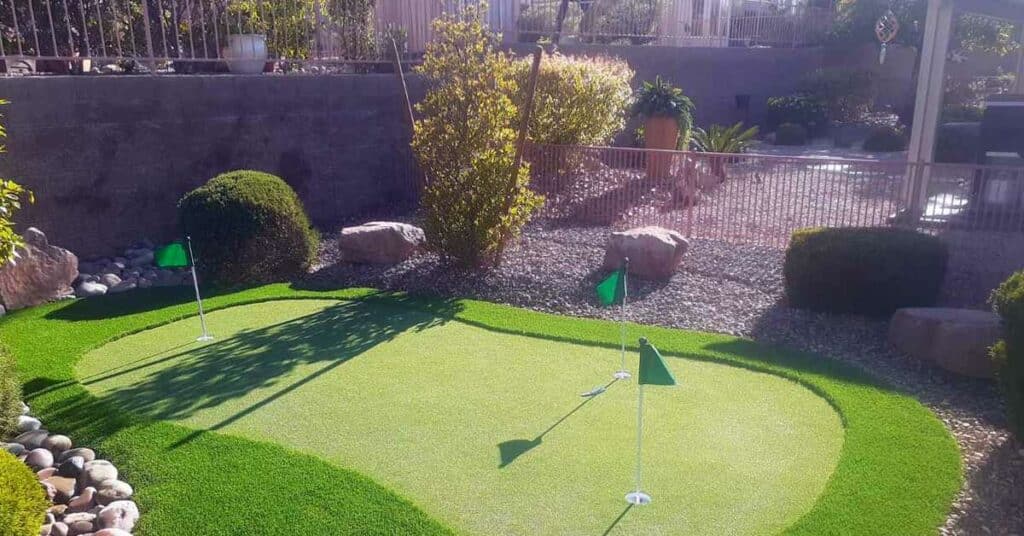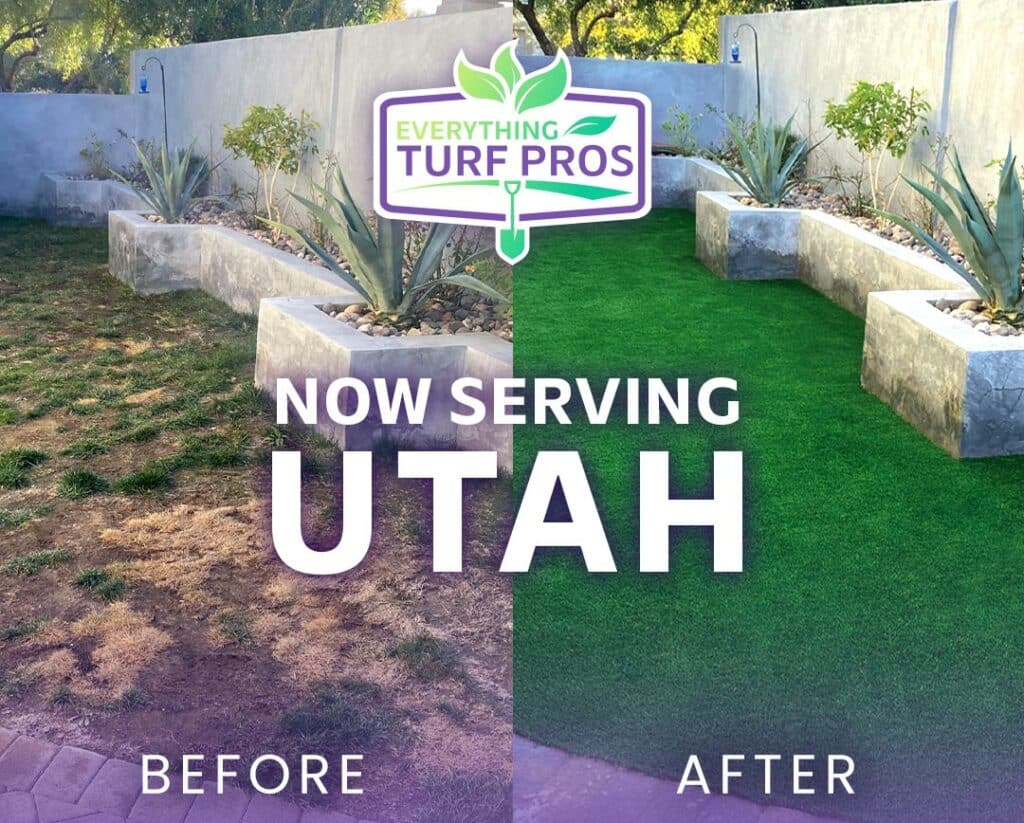Desert Landscaping is Water-Smart
Landscaping a project in the hot, dry, Southwestern climate can be tricky. Here in Las Vegas, where Everything Turf Pros is located, artificial turf is highly advocated for as an alternative to real grass turf lawns, which require a large amount of water to keep it green, and comfortable to relax or play on.
Making the decision to either build a desert landscape from scratch or rip up a living grass lawn to make a water-smart landscape is a major choice. Artificial grass is a great alternative, however, the goal of artificial grass is not to completely diminish life in your yard. While water conservation is important to Southern Nevada, where Everything Turf Pros is located, we do not want to strip it of life. The goal of desert landscaping is to support life that can thrive naturally in Southern Nevada’s environment without water waste while adding the benefits of plants.
Starting on Your New Landscape
As professional landscapers and artificial turf installers, we have seen both replacement and new projects. Either way, Everything Turf Pros can bring you a gorgeous lawn full of natural, living tones of greens as well as artificial, lifeless greens. We believe the color brought by cacti, perennials, shrubs, etcetera, mixed with vibrant green hues of artificial turf is the best desert landscaping we can bring you.
Water waste can easily be reduced by solely taking out living turf grass and replacing it with artificial turf. Grass does not naturally thrive in deserts, but there are many drought-tolerant plants that can be utilized in your landscape, whether they are freshly planted or preserved from a prior yard. The Southern Nevada Water Authority offers a $3.00 cash rebate per square foot of living grass ripped up and replaced with water-smart landscaping, though a requirement of the rebate is that 50% of the landscaping has to be living.
This is actually much simpler than it seems. Your goal for installing turf might be to wipe your hands clean of caretaking responsibilities altogether. We assure you that most desert plants take minimal care, just like artificial turf. Some herbage actually takes less attention than turf! The Southern Nevada Water Authority has a long, comprehensive list of regional, desert plants—the list itself is extensive, but it includes plants such as a purple prickly pear cactus, a jojoba shrub, or an artichoke agave, and more.
Ins and Outs of Landscaping: Living with Lifeless
The difficulty of mixing living with lifeless
The only thing that should be genuinely looked out for in living vegetation is rhizomatic plants. These are stems that grow horizontally, under the surface level of the grass. This causes an issue with turf because they can begin to grow outward, underneath your newly installed turf, causing the installation to go awry. While our installation utilizes technologies to help avoid this, horizontal growth can eventually break through and erode the bases of your artificial turf.
For example, bamboo is attractive, but insufficient for a turf application, as it is rhizomatic. Irises are beautiful flowers, however, their rhizomatic stems may break through your fancy faux grass. Other rhizomatic species commonly used as spices are ginger and turmeric, so it may be best to avoid adding them to your new in-ground landscaping plan.
Trees
While we recommend letting us tend to the landscaping and installation, we want to share the ins and outs of installing something lifeless around something that needs nutrients.
A new project is a blank canvas, whereas a replacement yard may already have plants—and just because the grass is being ripped up, does not mean the already planted, desert tolerant life should be. A common pre-existing sustainable plant . As professional installers, we know how to incorporate a freshly planted or living tree into your water-smart landscape. The thing about turf is that it can block nutrients—therefore, space is required between roots and artificial grass. You may often see rocks or soil around the base of a tree with a clear divider between the artificial turf and the soil. This is often called a tree well. It protects the turf from suffocating your tree! That sounds a bit scary, but there is also the benefit of your tree losing the competition for nutrients that living grass would cause.
If you are starting from scratch, you may likely want a tree or two in your new lawn for some nice shade, height, and color. Artificial turf is made from plastic, which does not cool down like natural grass. While Turf Envy utilizes T°Cool® infill to keep its turf up to 50°F cooler, a shady spot might be a good call. Maybe even swing for a new chair to put underneath it! If you do not have a current shady friend, we may recommend to you something like an Acacia Anuera—a tree with a hardiness zone of 8-11 and a provider of extensive shade.
Hardiness ratings explain what regions can sustain certain forms of plant life. For a more detailed map and understanding of the Las Vegas area’s hardiness zone ranges from about 8-9, which you can view here. These ratings are based on temperature and climates.
Gardens
Maybe you have a smaller garden you want to keep intact. First off, let us reassure you this is more than possible. It is no sweat to map out a landscape around a flower or herb garden, marking off space for something already cultivated! But we are also excited to help you plan further incorporation of life that can flourish next to artificial turf.
Colorful desert flowers, along with shrubs and succulents make great additions to any desert landscaping designs. Did you know lavender is a very drought-resistant plant after its first blooming season? Or, have you ever seen a portulaca? Birds&Bloom wrote an article all about plants that are drought tolerant that will add eye-catching hues and thrive in dry environments, such as the catmint or lantana. The blog does not include information on their root systems, and unfortunately many have rhizomatic stems, such as the coneflower, Agastache, or salvia. It is important to do research on drought-tolerant plants to ensure a cohesive yard of living organisms with artificial turf.
Do you have a fence? If not, maybe consider taller, ornamental grasses! There are plenty lengthy in height without rhizomes that can offer privacy and a nice addition to your water-smart landscape. And, if privacy is not your aim, they still make lovely additions to gardens. Like all living organisms, you aim to landscape with artificial grass, a bit of research will need to be done to ensure they will cohabitate nicely with your new plastic grass. Luckily, we have done some for you—perhaps mull over adding a pampas grass, a purple fountain grass, or a giant feather grass! You can view more SNWA-approved plants here!
Plants benefit YOU!
While artificial turf can be for play, sunbathing, socializing, and many more things, it is plastic. Plastic does not have the same physical or mental benefits that living organisms do, such as improving air quality or mood as plants and gardening can.
When it comes to desert landscaping, artificial turf is the most similar and water conscious alternative to living grass. It would be difficult to bask in the sun on a bed of perennials, and dangerous to run around on rocks. Artificial turf is the idyllic alternative to grass, but it is not living. We do not want to desert the region of life, but rather bring life that can genuinely thrive to the desert.
Whether you are angling for the $3.00/square foot rebate for the SNWA, or believe that a mix of living plants with lifeless turf is the best landscaping balance for the Southwestern climate, Everything Turf Pros can be a resource to you. As experts in landscaping and installation, there is no better team to provide you with a more attractive, water-smart, living and artificial lawn than us here at Everything Turf Pros.



